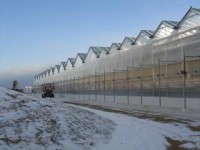Weathering The Winter

Well, it’s soon to be winter again. Those hot summer days are but memories to many growers, and it’s time to winterize your greenhouse. Your greenhouse should be checked inside and out to reduce winter disasters.
Beginning on the exterior, check that all of your doors close and seal properly. A poor closing door blown open in the middle of a cold winter night could be disastrous, not to mention potential heat loss.
Repair any holes that your forklift or other equipment might have put in the wall coverings. To increase your usable sunlight during winter’s low light levels, wash your roof and wall coverings. Check your poly manufacturer for specific instructions on cleaning. But for the most part, just use warm soapy water–nothing abrasive–and a soft cloth, and it will clean up nicely. Make sure you specifically clean any place you will be applying poly patch so it will adhere better.
Now for the fun part: inspecting your roof covering. Be sure to look for any holes or tears. Carry a roll of poly patch tape to repair the poly roof tears and reinstall any lock inserts which might have come loose. You’ll also want to clean the gutters to maximize runoff capability from winter storms. Check the gutters for any maintenance that might need to be done.
On the interior, continue the repair of any holes in the covering. This is a good opportunity to install a manometer in your poly roof. A manometer checks roof pressure and monitors it throughout the year. A properly adjusted inflation fan should maintain a water pressure reading of 0.25 inches.
Check your energy curtains, vents and rack and pinions to ensure that they work properly and close tightly. As you adjust the rack and pinions, lubricate them with a dry moly lubricant. Your ventilation equipment should be inspected, and any problem fixed or noted for your spring maintenance program.
Drain your pad system and clean the pads. You may want to take your pad out, and after cleaning, store it for the winter. There are some good bromide cleaners on the market that will clean the calcium from the pads in an environmentally safe fashion. Even in a year-round warm climate, you will want to do periodic cleaning to maximize the efficiency of your unit.
Most importantly, your heating system needs to be inspected. Have a licensed service company do a pre-season check on your boilers or your unit heaters. Have them check your gas supply both for pressure and quality. Fire up all of the heating equipment to check the flame and its color to ensure they are burning properly. Inspect the vent stacks for leaks or obstructions. Check your boilers and pumps for water leaks and that all zone valves are working properly.
Make sure your auxiliary equipment is running properly, including your HAF fans or fan-jets. Replace any fan-jet tubes that are damaged or torn.
Examine your controls to verify they are adjusted to the correct winter temperature and that any alarms are hooked up and working. Cycle through your heat steps to ensure everything is set correctly.
If you have a back-up generator, now is the time to start it up to avoid any late-night surprises.
Call your local utility company and ask about any off-peak discounts for which you might qualify so that you can factor them in when you set the controls. Ask for a commercial representative. Once you know the times of day you’ll be using it, you might be able to make some subtle adjustments to your controls. Some people have saved considerable dollars with just a phone call. Periodically, the gas company sends inserts in your monthly bill offering their consultation at no charge. Take advantage of their expertise.
If you use black plastic to cover your mums, remember that it is sometimes in short supply. Make sure you notify your supplier in plenty of time. For those of you who use an “over-wintering” greenhouse, you may need to call your greenhouse manufacturer to order a Frost Guard or similar structure. These structures will protect your bare root stock and woody ornamentals from the wind. Verify that your poly has UV treatment and is not construction grade.








